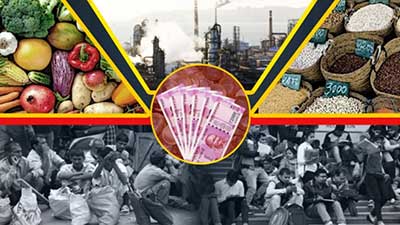Relevance: GS-3: Indian Economy and issues relating to planning, mobilisation of resources, growth, and development.
Key Phrases: Rising food Inflation, Headline Inflation, Vegetable Inflation, Fiscal Policy, Monetary Policy, Higher freight rates for transport, Inflation Targeting, Sequential Price Rise, Consumer Price Index-based Inflation
Why in News?
- Food inflation, which was at 6 percent on average in the past three years, is significantly higher than the pre-pandemic five-year average of 3.5 percent.
- It has further risen in recent months, making it difficult for monetary policy to anchor inflation expectations.
Key Highlights:
- The drivers of current inflation are external but their second-round effects are becoming a source of concern, as domestic demand improves and feeds into inflation expectations.
- Research has shown that the frequency of purchase, rather than the share of expenditure, shapes inflation-related expectations of consumers.
- Around 40 percent of overall consumer spending is on food and its purchase frequency is also higher.
- Thus rising prices have a stickier impact on inflation expectations.
Why is food inflation surging?
- Various factors for rising food inflation include
- A surge in transportation costs
- The rising cost of production
- Elevated global food prices.
- The first two are already being passed on to retail prices. For instance, a sharp rise in transportation costs has pushed up retail prices of agricultural commodities.
- Vegetable inflation surged the most in April, led by both a high base and sequential increase in prices.
- Higher freight rates for transport would have a huge role to play in driving up retail prices.
- As per CRISIL Research's CRISFrex Index, freight costs for agricultural products rose more than 20 percent on-year as of April, suggesting transporters have been passing on higher diesel prices by raising freight rates.
- Similarly, other than vegetables, inflation has also been firming up in other domestically produced commodities such as wheat and products, coarse cereals, and meat.
- Apart from a low base, there is a sequential price rise in these components. In many of these, food production costs have risen, driven by higher diesel, fertiliser, pesticides and also animal feed prices.
- The Russia-Ukraine war is affecting everything, even food prices in a nation where most of what is consumed is produced locally.
- In April, the consumer price index-based inflation for food had reached 8.4 percent.
- Initially, it started picking up for imported commodities when global food prices started surging since the war began, with edible oils and cereals rising the most. But now, domestically produced items are getting caught in the price fire.
- Recent months have also seen a narrowing of the gap between wholesale and retail food inflation, suggesting a higher pass-through of input costs.
- The heatwave has further increased the difficulties.
Impact of rising food inflation:
- Rising food inflation hurts consumers a lot more than inflation in other commodities since households do not have much discretion in altering food consumption.
- The consequences are more adverse for certain consumer segments.
- The rural population spends a higher share (around 47 percent) than the urban (roughly 30 percent) on food.
- Similarly, the bottom 20 percent shell out a higher share (60 percent) on food consumption.
- It is these segments that are facing the brunt of high food inflation for the past three years.
- Hence, the policy will have to relieve the pressure on food inflation wherever possible.
Measures taken by the Government:
- Monetary policy:
- Monetary policy made the first move by hiking the repo rate, and the cash reserve ratio, and gradually winding down the easy liquidity situation.
- We expect the RBI to raise repo rates by another 75-100 basis points in the rest of this fiscal.
- Fiscal Policy:
- This involves a reduction in excise duties on petrol and diesel, an increase in fertiliser and cooking gas subsidies and allowing duty-free imports of edible oils to alleviate the burden on consumers.
- Government Programs:
- Additional steps such as an extension of the Pradhan Mantri Garib Kalyan Anna Yojana beyond September may be needed.
Conclusion:
- Crucially, there is little monetary and fiscal policies can do to soften the primary exogenous blow in the short term.
- The pressure on the prices of agricultural commodities will take time to soften.
- This should be after the Russia-Ukraine conflict de-escalates and the impact gradually fades away.
- Until then, the Indian consumer will have to spend more.
Source: Indian Express
Mains Question:
Q. Discuss the causes for the rising food inflation across the country and the measures being taken by the government to alleviate the burden on customers. (250 words).








